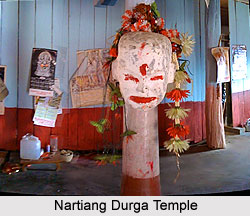 Nartiang Durga Temple is located in the Jaintia Hills district in the Indian state of Meghalaya. It is 500 year old temple. As per legend it is one of the 51 Shakti Peethas of Hindu Mythology. It is thus regarded as one of the holy places for the devotees Shakti cult of Hinduism.
Nartiang Durga Temple is located in the Jaintia Hills district in the Indian state of Meghalaya. It is 500 year old temple. As per legend it is one of the 51 Shakti Peethas of Hindu Mythology. It is thus regarded as one of the holy places for the devotees Shakti cult of Hinduism.
History of Nartiang Durga Temple
The history of the temple dates back to the ancient times. The temple is associated with an interesting mythological legend according to which once during a sacrificial feast the father of Goddess Parvati, Daksha did not invite Lord Shiva, his son-in-law. Parvati felt very humiliated and depressed at the insult of her husband and hence immolated herself at the sacrificial fire at her parents` home. Lord Shiva when came to know about the incident he became furious and in rage carried the dead body of his wife on his shoulders and began performing the dance of destruction. Lord Vishnu in order to pacify him cut down Durga`s dead body into 51 pieces with his flying discus or Chakra. These pieces fell in various parts of the world that later developed into temples and religious places. At Nartiang in the Jaintia Hills the left thigh of Goddess Durga fell. It is for this reason that the Goddess is known as `Jainteshwari`.
According to another story, the Jaintia king Jaso Manik (1606-1641) had married the daughter of the Hindu Koch king Nara Narayana, Lakshmi Narayana. She is said to have influenced the Jaintia Royalty to accept Hinduism. Almost 600 years ago King Dhan Manik had made Nartiang was the summer capital of the Jaintia Kingdom. It said that the
Goddess had appeared in his dreams and told him about the importance of the place. She also instructed him to erect a temple here in her honour. Thus the king built the temple of Jainteshwari in Nartiang. It is believed that the temple was earlier a part of a fort of the Jaintia Kings.
Worship of Nartiang Durga Temple
 Regular worship of the deity of the goddess is done in Nartiang Durga Temple. The religious rituals of the temple are not performed in a traditional way but is a blend of the Hindu and ancient Khasi traditions. The main patron of the temple is the local chieftain or Syiem. During the Durga Puja goat and ducks are sacrificed here in honour of the goddess. It is said that earlier humans were scarified here but later the British government put a stop to it. During the sacrificial ceremony the goats are made to wear human masks and then sacrificed. During the festival of Durga Puja a banana plant is dressed up and is worshipped as the goddess. After the end of the festival the banana plant is ceremoniously immersed in the Myntdu River. Guns are also fired in salutation to the goddess.
Regular worship of the deity of the goddess is done in Nartiang Durga Temple. The religious rituals of the temple are not performed in a traditional way but is a blend of the Hindu and ancient Khasi traditions. The main patron of the temple is the local chieftain or Syiem. During the Durga Puja goat and ducks are sacrificed here in honour of the goddess. It is said that earlier humans were scarified here but later the British government put a stop to it. During the sacrificial ceremony the goats are made to wear human masks and then sacrificed. During the festival of Durga Puja a banana plant is dressed up and is worshipped as the goddess. After the end of the festival the banana plant is ceremoniously immersed in the Myntdu River. Guns are also fired in salutation to the goddess.
Presently, the Central Puja Committee takes care of the temple. It is the official representative of the Hindu community in the state of Meghalaya. The trust is also entrusted with the repair and renovation of the temple. It also funds a handsome amount for the regular temple activities. The holy temple is visited by many devotees from different places who flock here to offer their worship at the feet of the goddess and receive her blessings.





















